Therizinosauria
|
The Maniraptora is a clade of theropods that are characterized by a distinctly shaped carpal (wrist) bone and in most by a backward pointing pubis bone. Probably all had feathers, and in most (except the Therizinosaurs), the feathers had flat vanes. This clade also includes the birds.
The Therizinosauria are an unusual clade of theropods. They had short, thick hind legs, broad hips, and a short tail. Their small heads and teeth more closely resembled those of the prosauropods than other theropods. These characteristics all suggest they were relatively slow-moving herbivores. Their most distinctive feature was elongated forelimbs ending in huge, curved claws that may have functioned to pull down vegetation or in defense against predators.
Nothronychus graffami was the first therizinosaur to be discovered in North America.
Taxonomy: Theropoda, Coelurosauria, Therizinosauria
Southwestern United States
Late Cretaceous Period, 80 Ma
Arizona Museum of Natural History
|
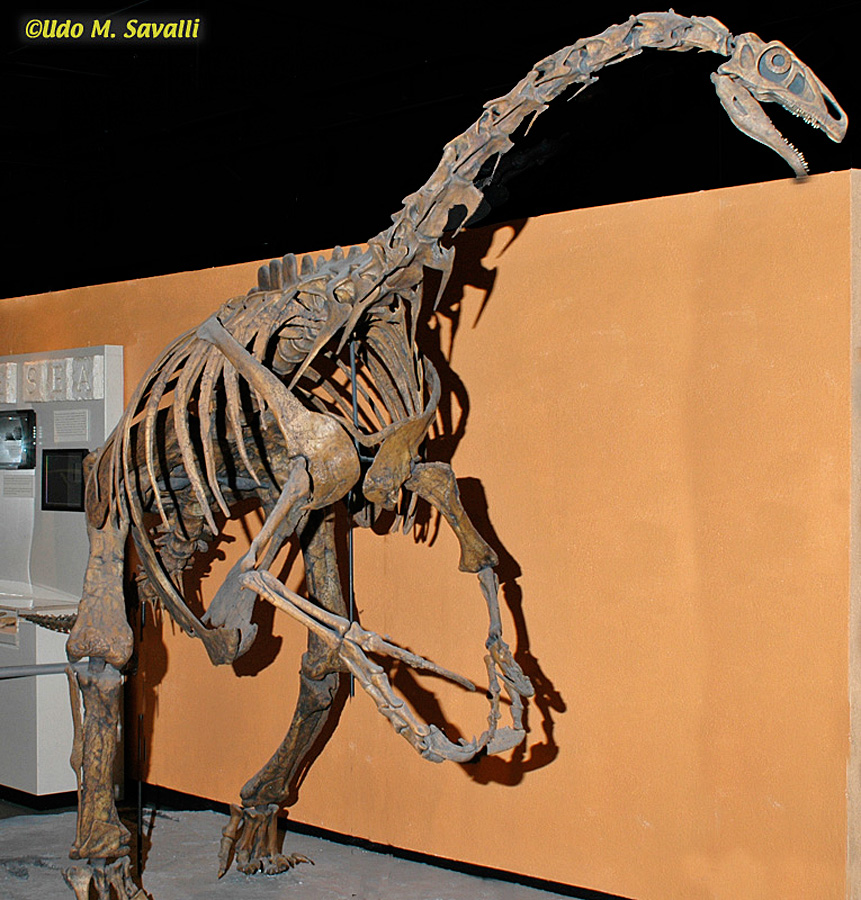
|
|
|
Nothronychus sp. skeleton, clearing showing its broad pelvis and gut and unusual stance.
Taxonomy: Theropoda, Coelurosauria, Therizinosauria
Southwestern United States
Late Cretaceous Period, 92-91 Ma
Wyoming Dinosaur Center
|
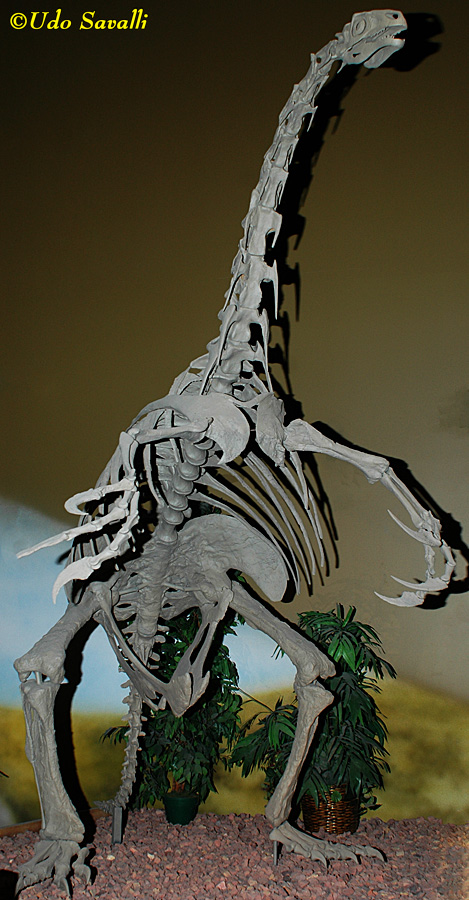
|
|
|
Falcarius utahensis was a primitive therizinosaur, and as such its proportions were less extreme and more like typical theropods.
Taxonomy: Theropoda, Coelurosauria, Therizinosauria
Utah
Early Cretaceous Period, 126 Ma
Wyoming Dinosaur Center
|
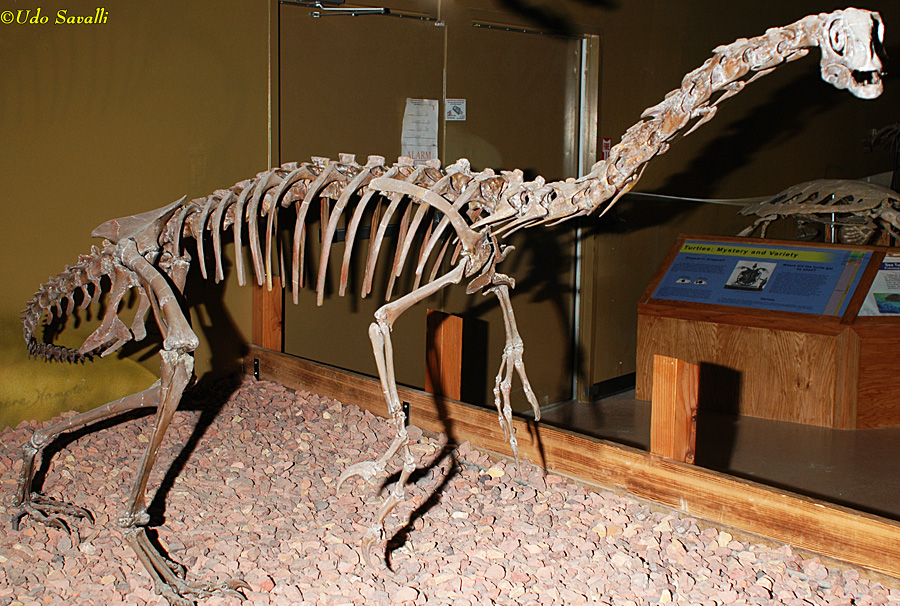
|
|
|
The manus (hand) of Therizinosaurus cheloniformis. When covered in their keratinous sheath, these claws may have been up to 1 m long.
Taxonomy: Theropoda, Coelurosauria, Therizinosauria
Nemegt Formation, Mongolia
Late Cretaceous, Campanian-Maastrichtian Stages
Black Hills Institute Museum, South Dakota
|
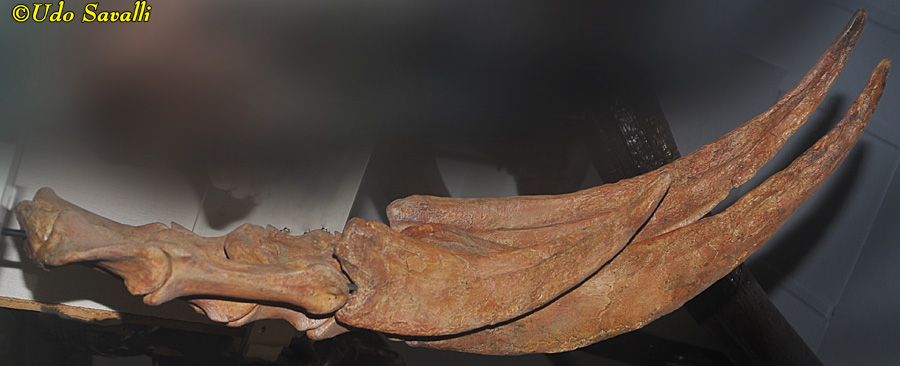
|
|
|
Egg clutch of the therizinosaur Segnosaurus sp.
Taxonomy: Theropoda, Coelurosauria, Therizinosauria
Mongolia
Late Cretaceous Period, 90 Ma
Museum of Ancient Life, Utah
|
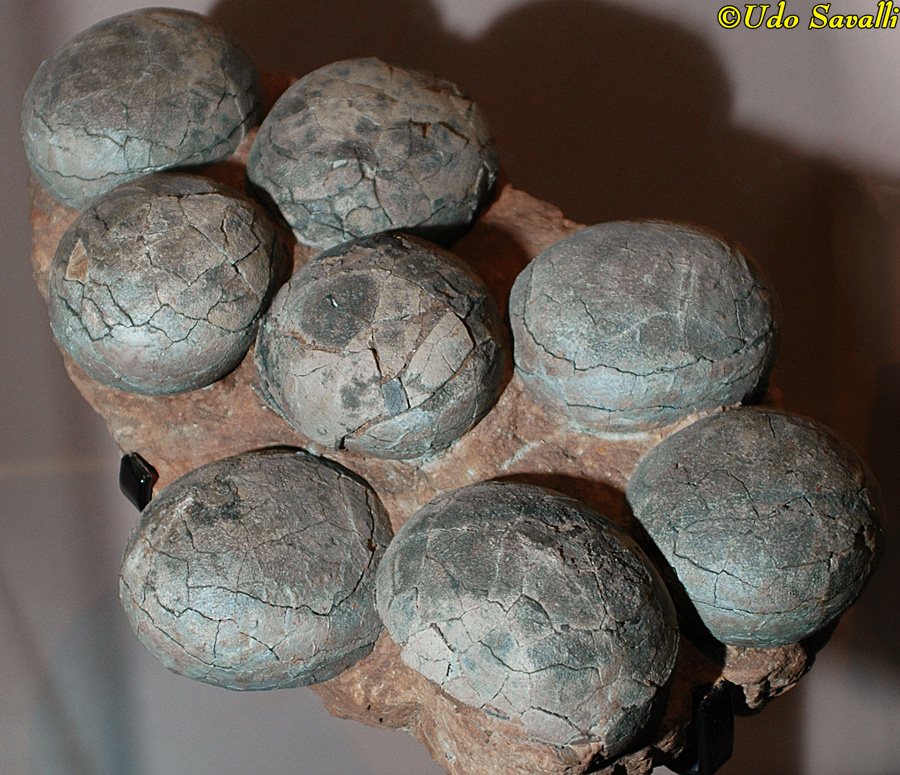
|
|
Oviraptorosauria
|
The Oviraptorosauria are a distinctive group of maniraptoran theropods. They were mostly fairly small (but a few species did reach very large size), long-legged, long-armed, short-tailed, and with a distinctive skull that was short, blunt, and with a curved, mostly toothless beak.
Conchoraptor gracillis: Note its overall build, with long arms and a short tail and a short skull with parrot-like beak.
Taxonomy: Theropoda, Coelurosauria, Oviraptorosauria, Oviraptoridae
Omnogov Formation, Mongolia
Late Cretaceous Period, 80 Ma
Rocky Mountain Dinosaur Resource Center, Colorado
|
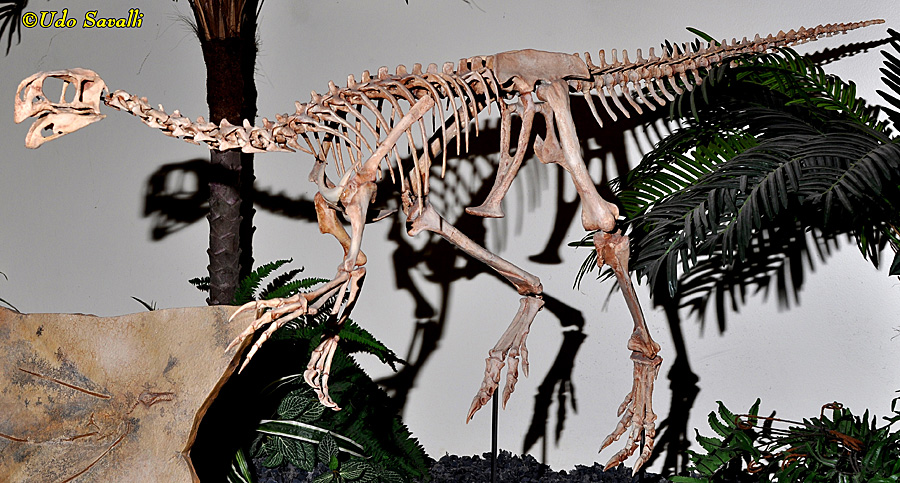
|
|
|
Conchoraptor gracilis fossil.
Taxonomy: Theropoda, Coelurosauria, Oviraptorosauria, Oviraptoridae
Red Beds of Khermeen Tsav, Mongolia
Late Cretaceous Period, Campanian Stage
Black Hills Institute Museum, South Dakota
|
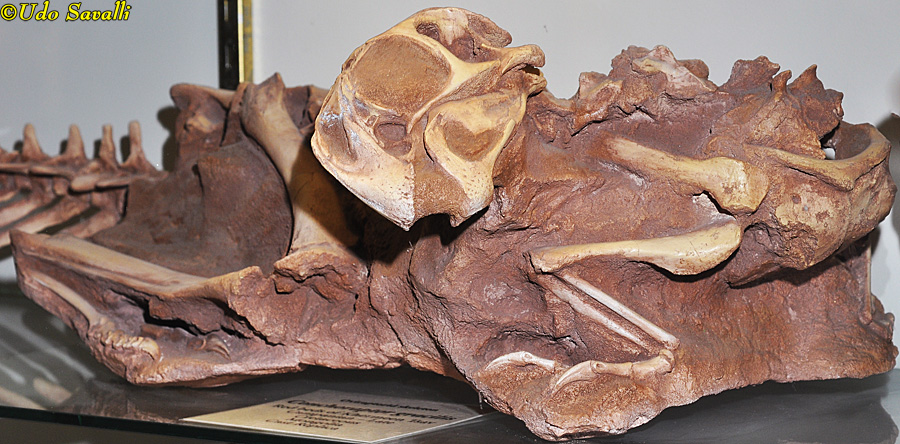
|
|
|
Many oviraptorosaurs had bony crests on their skulls, such as this Citipati osmolskae (a species often confused with Oviraptor due to some unnamed specimens).
Taxonomy: Theropoda, Coelurosauria, Oviraptorosauria, Oviraptoridae
China
Late Cretaceous, Campanian Stage, 75 Ma
Arizona Science Center (temporary exhibit)
|
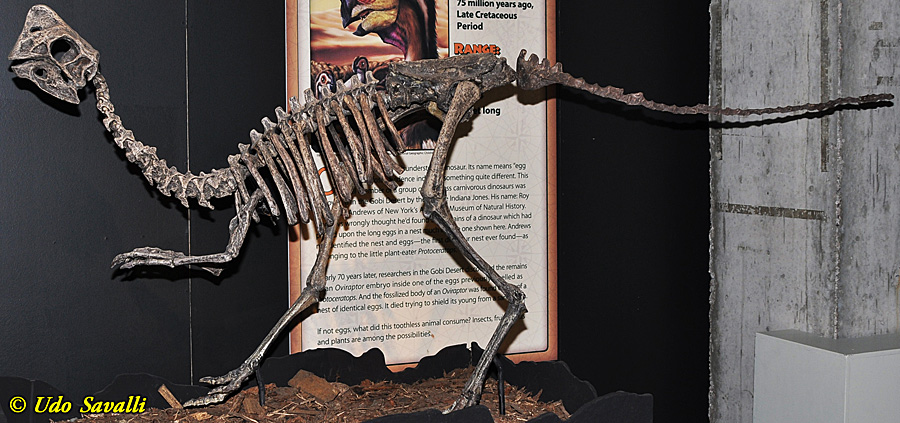
|
|
|
Anzu wyliei reconstructed skeleton.
Taxonomy: Theropoda, Coelurosauria, Oviraptorosauria, Caenagnathidae
Hell Creek Formation, Harding Co., South Dakota
Late Cretaceous Period, 66 Ma
Rocky Mountain Dinosaur Resource Center, Colorado
|
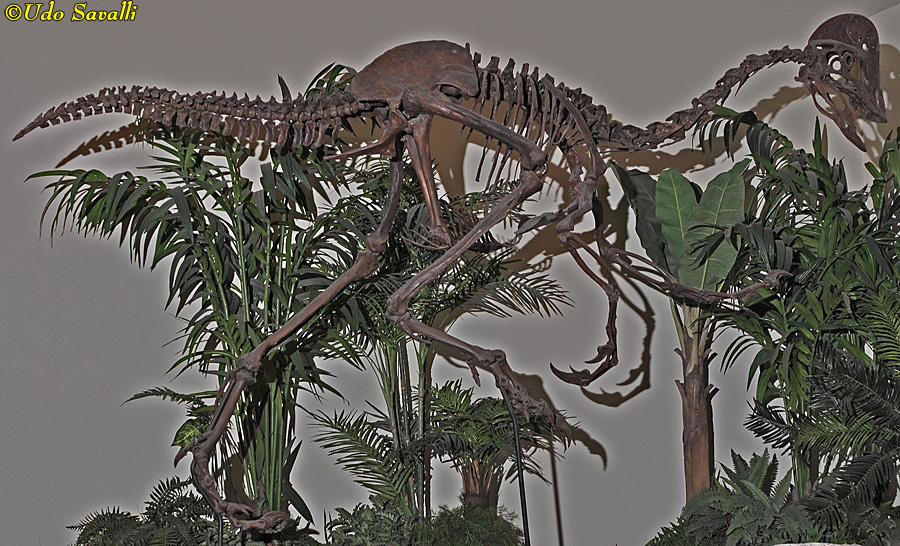
|
|
|
Cast of an undescribed oviraptorid fossil (nicknamed "Ronaldoraptor"). The crest and thus top of the head is to the left, the beak is facing downward, and the largest opening roughly in the middle of the skull is the orbit.
Taxonomy: Theropoda, Coelurosauria, Oviraptorosauria, Oviraptoridae
Red Beds of Khermeen Tsav, Mongolia
Late Cretaceous, Campanian Stage
Black Hills Institute Museum, South Dakota
|
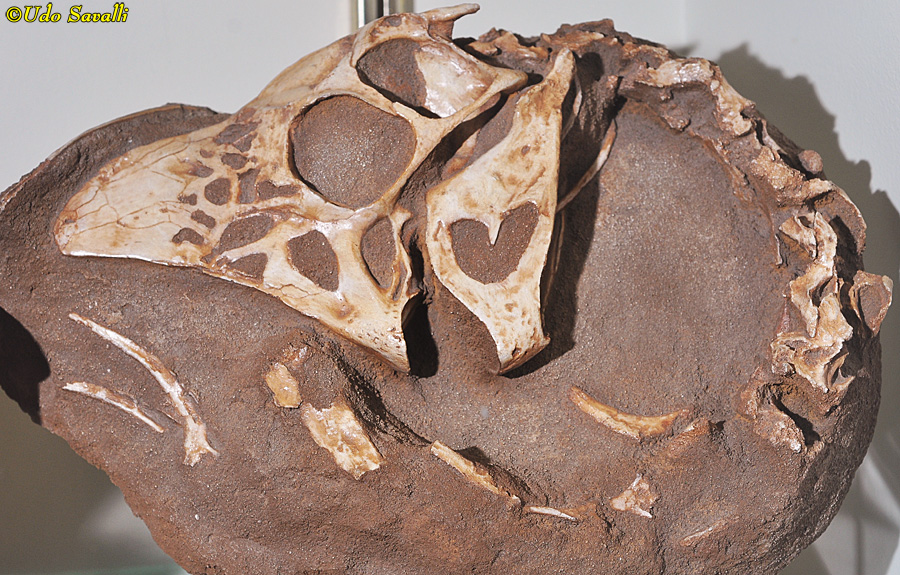
|
|
|
Caudipteryx zoui was a relatively primitive oviraptorosaur that preserved feather impressions as in this cast, indicating they had flat-vaned feathers on their arms and tail. Note also the cluster of gastroliths in its abdomen, which suggests an herbivorous diet.
Taxonomy: Theropoda, Coelurosauria, Oviraptorosauria, Caudipteridae
Liaoning, China
Early Cretaceous Period, 125 Ma
Los Angeles Museum of Natural History
|
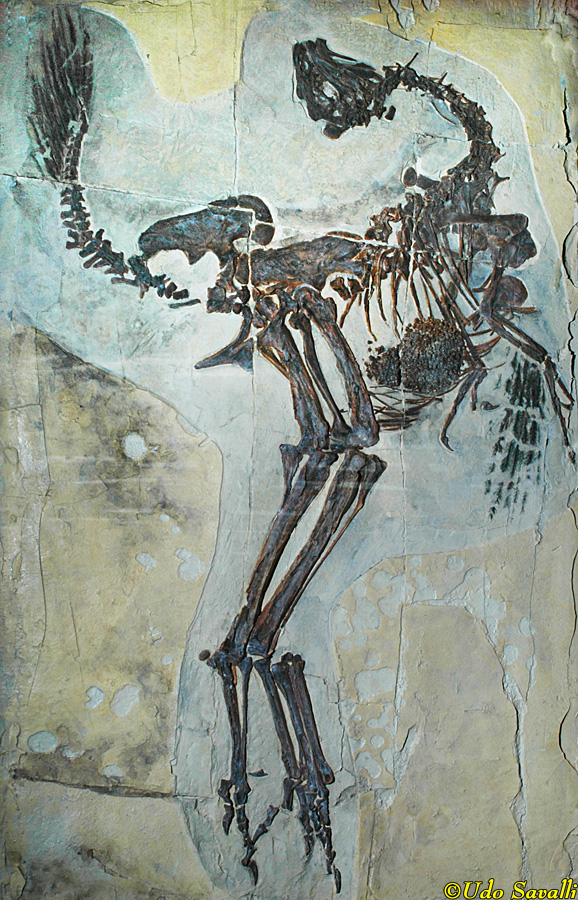
|
|
|
Caudipteryx zoui fossil cast.
Taxonomy: Theropoda, Coelurosauria, Oviraptorosauria, Caudipteridae
Yixian Formation, Liaoning Prov., China
Early Cretaceous, Aptian Stage
Black Hills Institute Museum, South Dakota
|
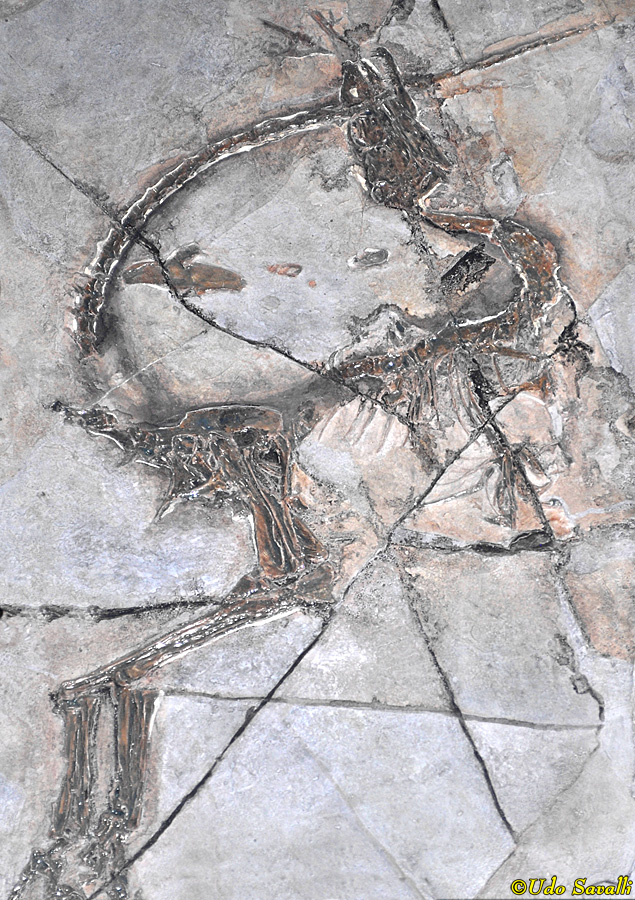
|
|
|
Life model of Caudipteryx zoui.
Taxonomy: Dinosauria; Theropoda; Maniraptora; Oviraptorosauria
Early Cretaceous Period, 130-125 Ma; China
Fernbank Museum of Natural History, Georgia
|
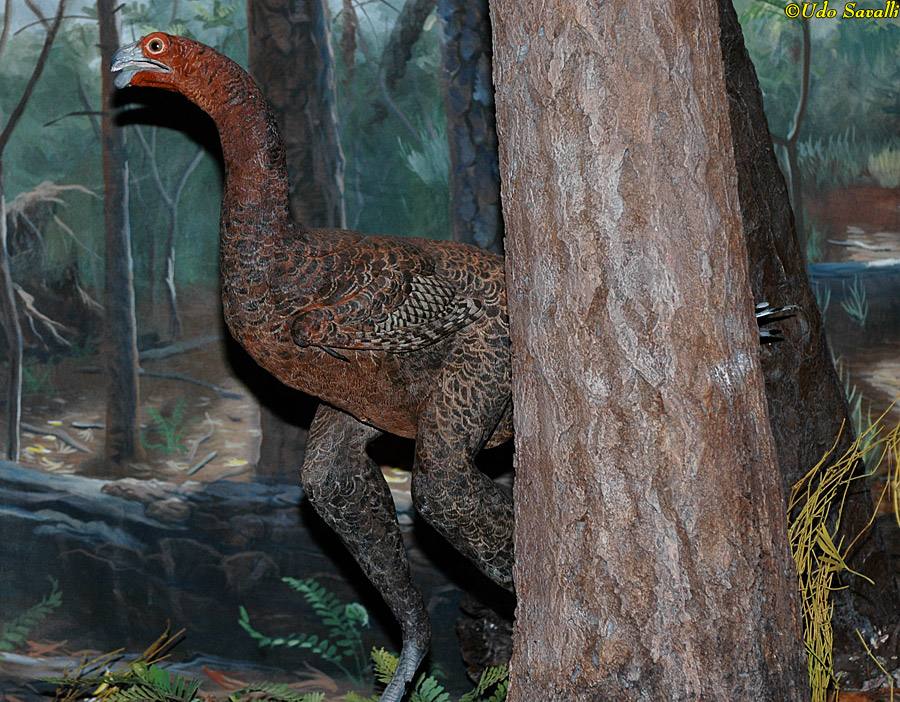
|
|
|
Beibeilong sinensis hatchling & egg shell fragments (cast of "Baby Louie"). This hatchling is generally believed to be closely related to Gigantoraptor, the largest species of oviratorosaur as an adult.
Taxonomy: Theropoda, Coelurosauria, Oviraptorosauria, Caenagnathidae
Henan Prov., China
Late Cretaceous, Cenomanian-Turonian Stages, 70 Ma
Los Angeles Museum of Natural History
|
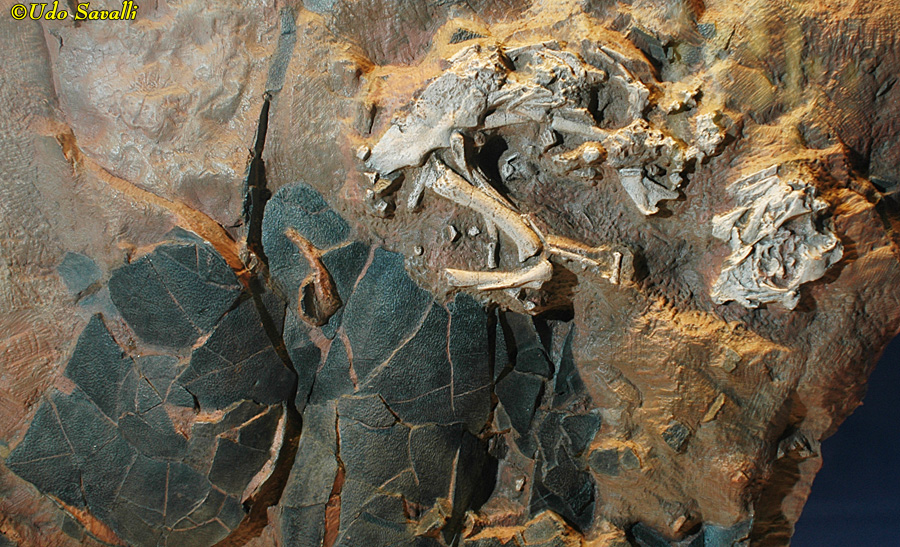
|
|
|
Egg with embryo of Oviraptor sp. The name Oviraptor, meaning "egg plunderer," was given under the mistaken assumption that the nest found with the first specimen belonged to a different species and was being raided. Subsequent discoveries of eggs with embryos verified that these eggs actually belonged to Oviraptor itself.
Taxonomy: Theropoda, Coelurosauria, Oviraptorosauria, Oviraptoridae
Nanxiong Formation, Jiangxi Prov., China
Late Cretaceous Period
Black Hills Institute Museum, South Dakota
|
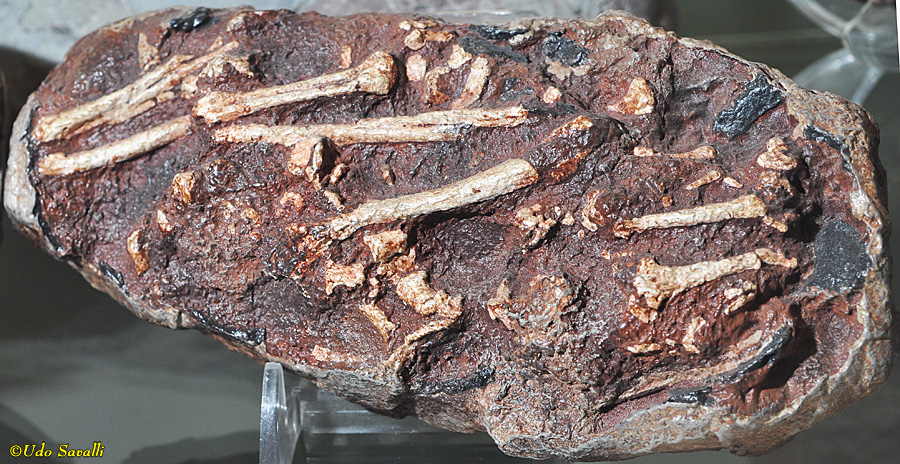
|
|
|
Clutch of Oviraptor sp. eggs.
Taxonomy: Theropoda, Coelurosauria, Oviraptorosauria, Oviraptoridae
China
Late Cretaceous Period, 75 Ma
Museum of Ancient Life, Utah
|
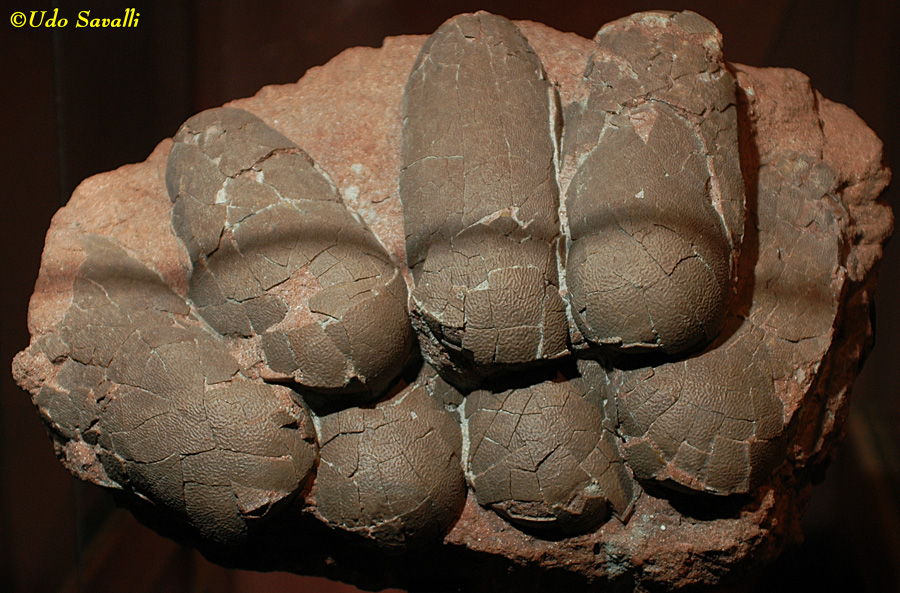
|
|
Dromeosauridae
|
The remaining theropod dinosaurs, as well as the birds, belong to the clade Paraves. These are the most bird-like dinosaurs with well-developed, vaned feathers and relatively long forelimbs. The most familiar of the non-bird Paraves is the family Dromeosauridae, popularly known as "raptors". Unlike their depiction in most modern fiction, the dromeosaurids were well-feathered and bird-like. They did have an enlarged, curved claw on their hind foot that was held elevated off the ground when they walked and may have functioned in subduing prey.
Although most people have heard of Velociraptor mongoliensis, the actual dinosaur is different from their expectation, being smaller, more slender-snouted, and fully feathered in life.
Taxonomy: Theropoda, Coelurosauria, Paraves, Dromeosauridae
Asia
Late Cretaceous Period, 75-71 Ma
Wyoming Dinosaur Center
|
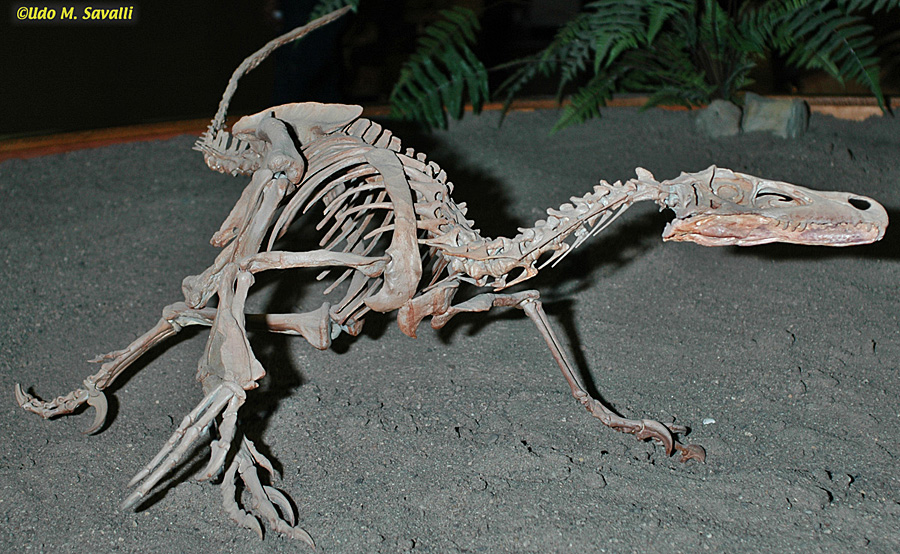
|
|
|
The skull of Velociraptor mongoliensis was elongated and concave along its upper surface and was probably adapted for capturing relatively small prey.
Taxonomy: Theropoda, Coelurosauria, Paraves, Dromeosauridae
Mongolia
Late Cretaceous Period, 75-71 Ma
Fernbank Museum of Natural History, Atlanta
|
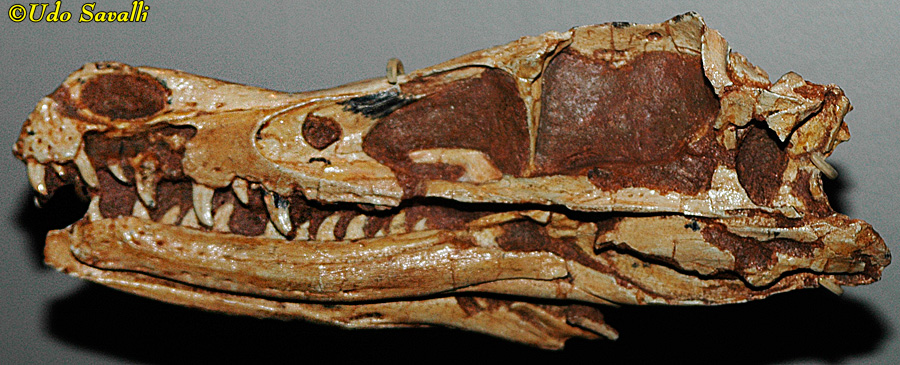
|
|
|
The "raptors" of Jurassic Park were actually based on Deinonychus antirrhopus, which was larger than Velociraptor (although still not as large as in the movie), but had a shorter, more robust head that more closely resembles the movie raptors (although it would have been fully feathered as well).
Taxonomy: Theropoda, Coelurosauria, Paraves, Dromeosauridae
Western North America
Early Cretaceous Period, 115-108
Wyoming Dinosaur Center
|
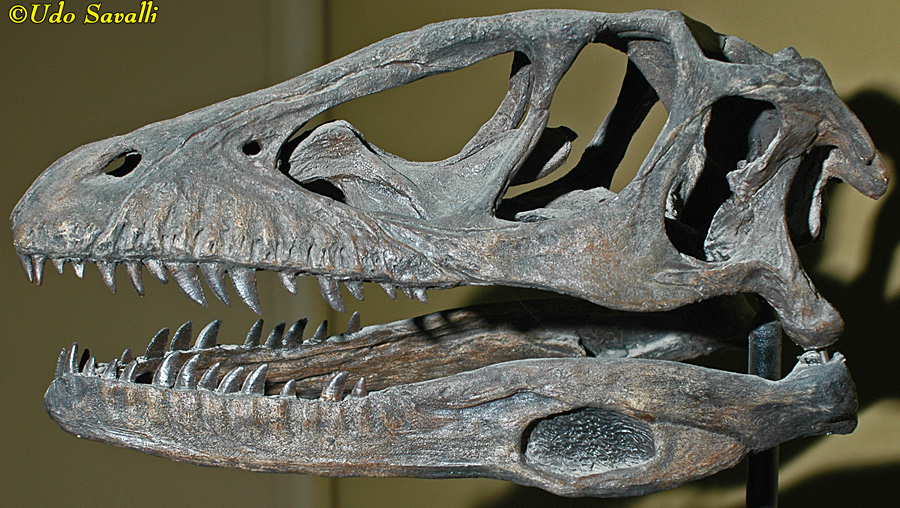
|
|
|
Bambiraptor feinbergi was a relatively small species (it may not be full grown and thus could be the young of another known species). Note the tail encased in stiff, ossified (turned to bone) tendons: only the base of the tail would have been flexible.
Taxonomy: Theropoda, Coelurosauria, Paraves, Dromeosauridae
Montana
Late Cretaceous Period, 75 Ma
Wyoming Dinosaur Center
|
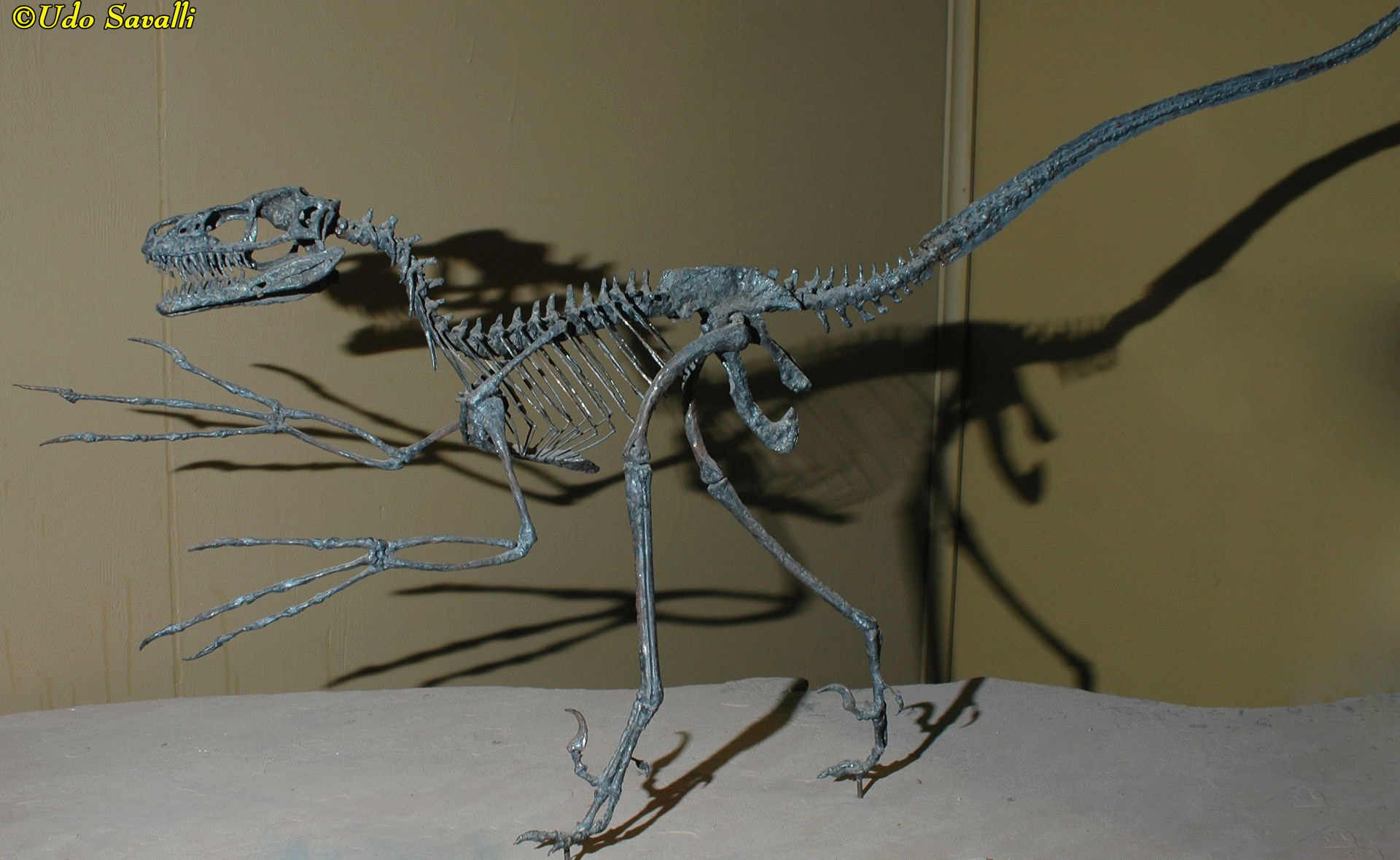
|
|
|
Bambiraptor feinbergi cast of in situ fossil.
Taxonomy: Theropoda, Coelurosauria, Paraves, Dromeosauridae
Two Medicine Formation, Montana
Late Cretaceous Period, 80 Ma
Rocky Mountain Dinosaur Resource Center, Colorado
|
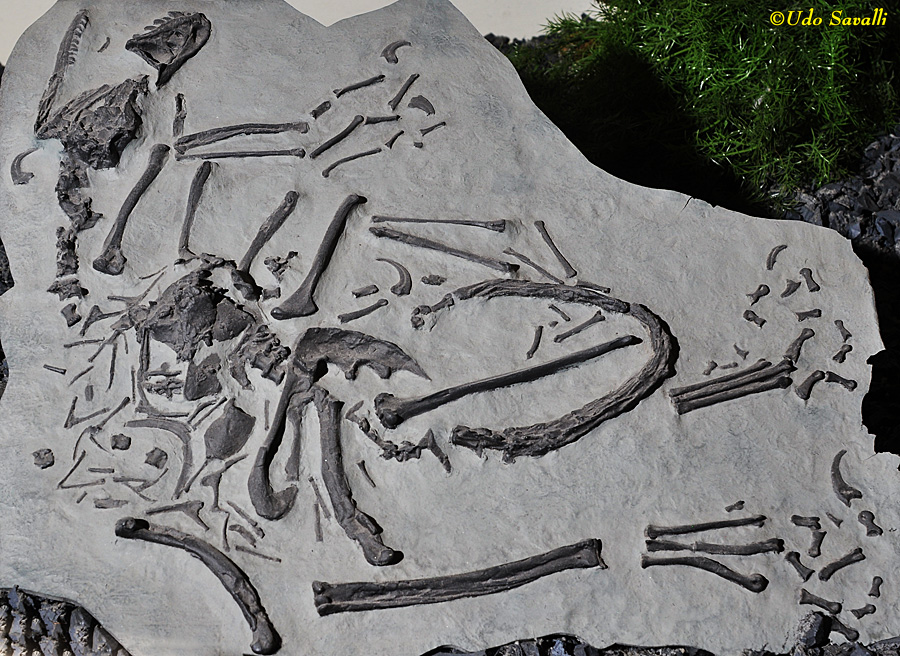
|
|
|
Dromaeosaurus reconstructed skeleton.
Taxonomy: Theropoda, Coelurosauria, Paraves, Dromeosauridae
Western North America
Late Cretaceous, Campanian Stage
Museum of Ancient Life, Utah
|
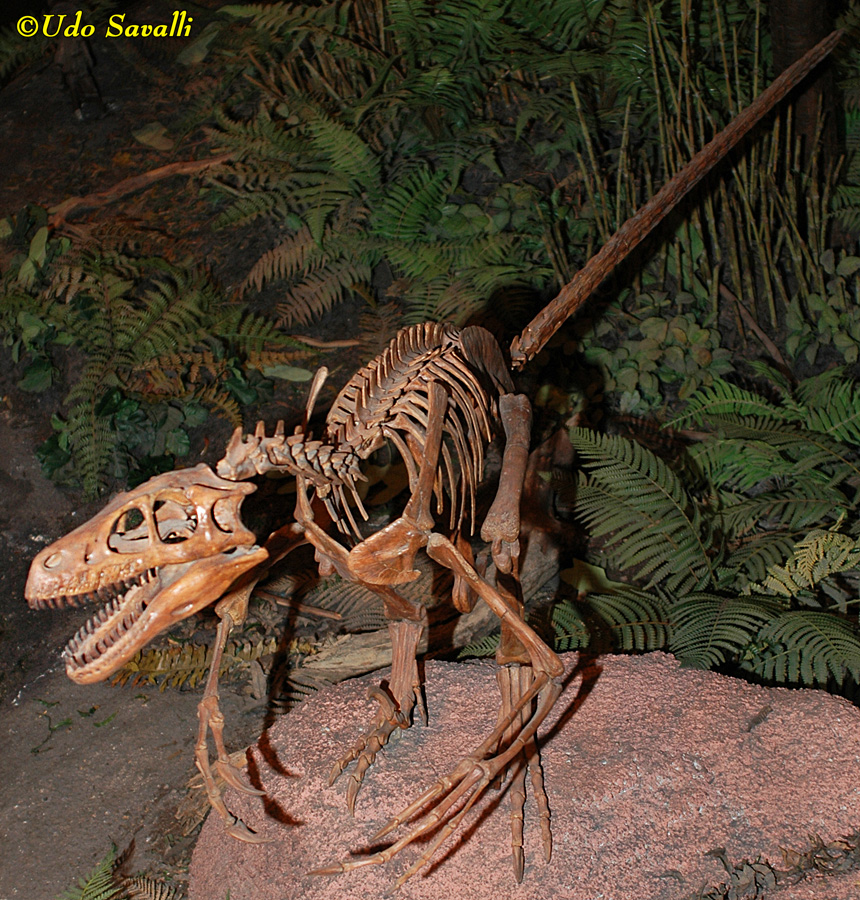
|
|
|
Reconstructed Saurornitholestes sp. skeleton.
Taxonomy: Theropoda, Coelurosauria, Paraves, Dromeosauridae
Glacier Co., Montana
Late Cretaceous Period
Museum of the Rockies, Montana
|
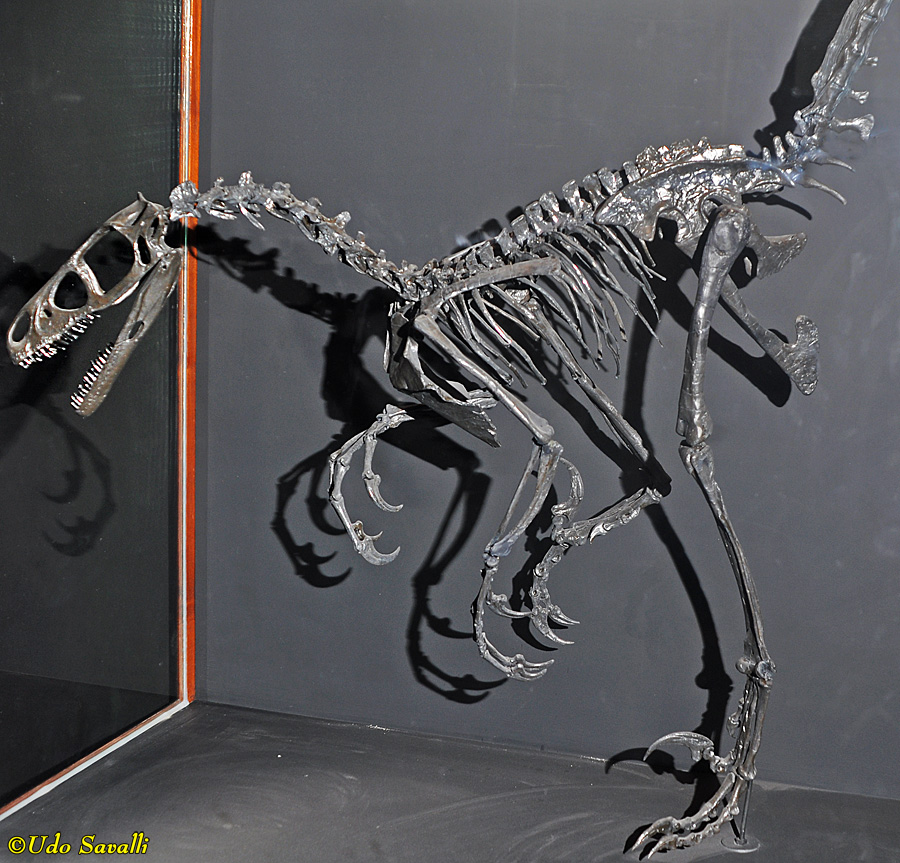
|
|
|
Sinornithosaurus millenii fossils include some soft tissue preservation showing a body covered in feathers.
Taxonomy: Theropoda, Coelurosauria, Paraves, Dromeosauridae
China
Early Cretaceous Period, 130-125 Ma
Fernbank Museum of Natural History, Atlanta
|
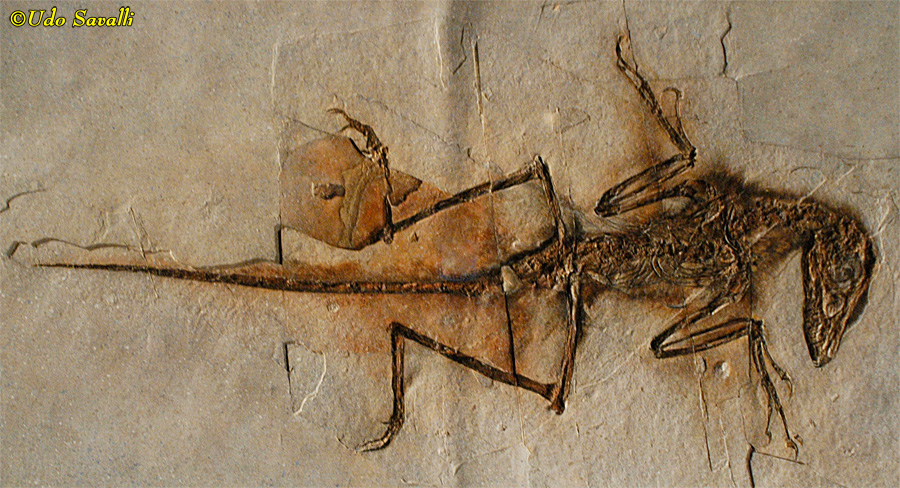
|
|
|
Sinornithosaurus millenii showing preserved feather impressions, including vaned feathers on the forelimb.
Taxonomy: Theropoda, Coelurosauria, Paraves, Dromeosauridae
China
Early Cretaceous Period, 130-125 Ma
Fernbank Museum of Natural History, Atlanta
|
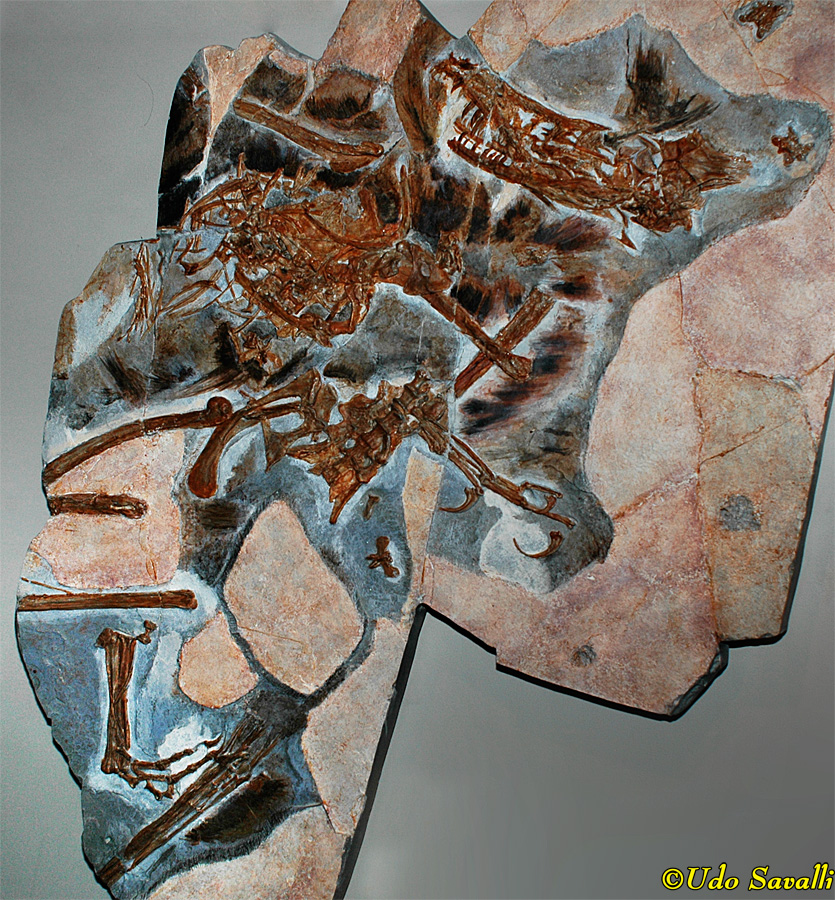
|
|
|
Life model of Sinornithosaurus millenii.
Taxonomy: Dinosauria; Theropoda; Maniraptora; Dromaeosauridae
Early Cretaceous Period, 130-125 Ma; China
Fernbank Museum of Natural History, Georgia
|
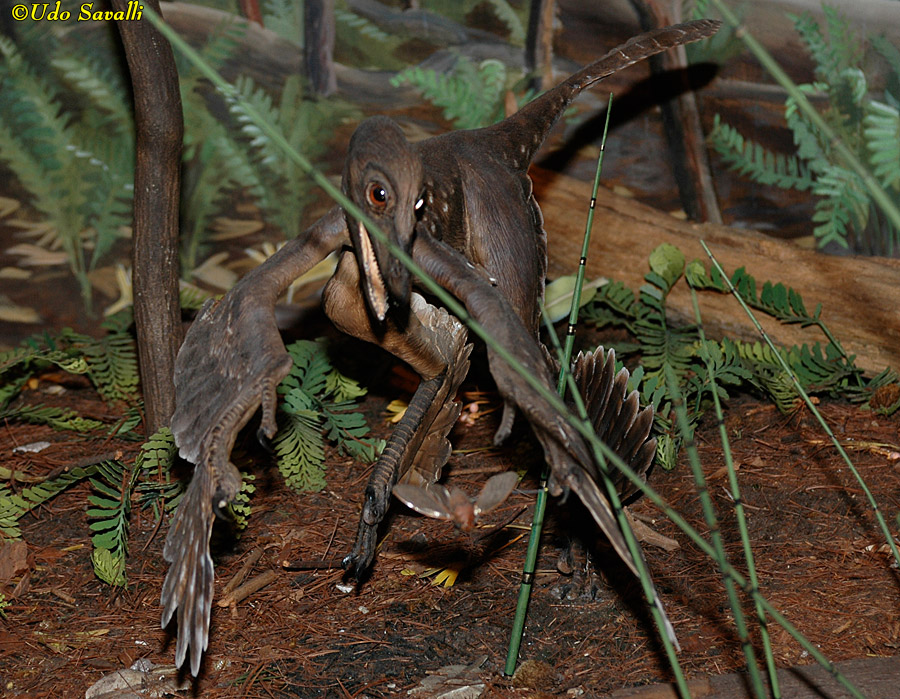
|
|
|
Microraptor gui not only had long, well developed vaned feathers on both the front and hind limbs, but these feathers were asymetric, indicating that they had an aerodynamic function. Modelling indicates that Microraptor was probably a glider.
Taxonomy: Theropoda, Coelurosauria, Paraves, Dromeosauridae
China
Early Cretaceous Period, 130-125 Ma
Fernbank Museum of Natural History, Atlanta
|
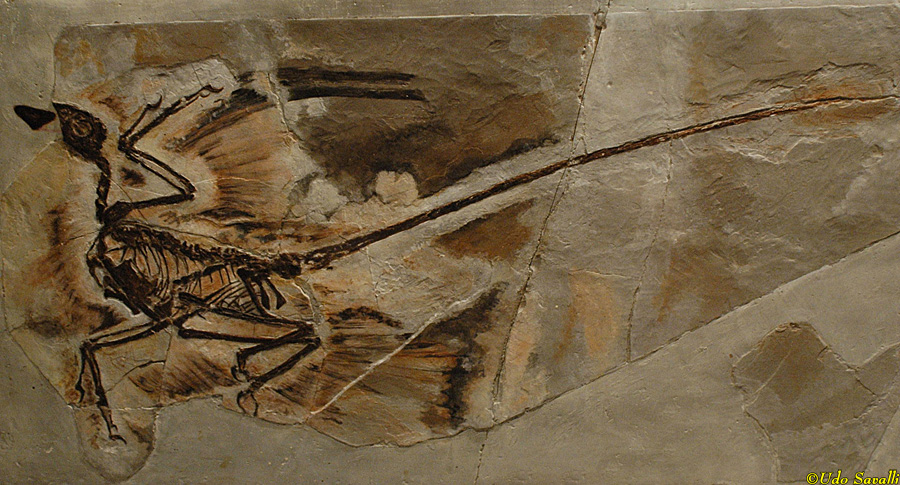
|
|
|
Microraptor sp. showing feather impressions.
Taxonomy: Theropoda, Coelurosauria, Paraves, Dromeosauridae
China
Early Cretaceous Period, 125 Ma
Wyoming Dinosaur Center
|
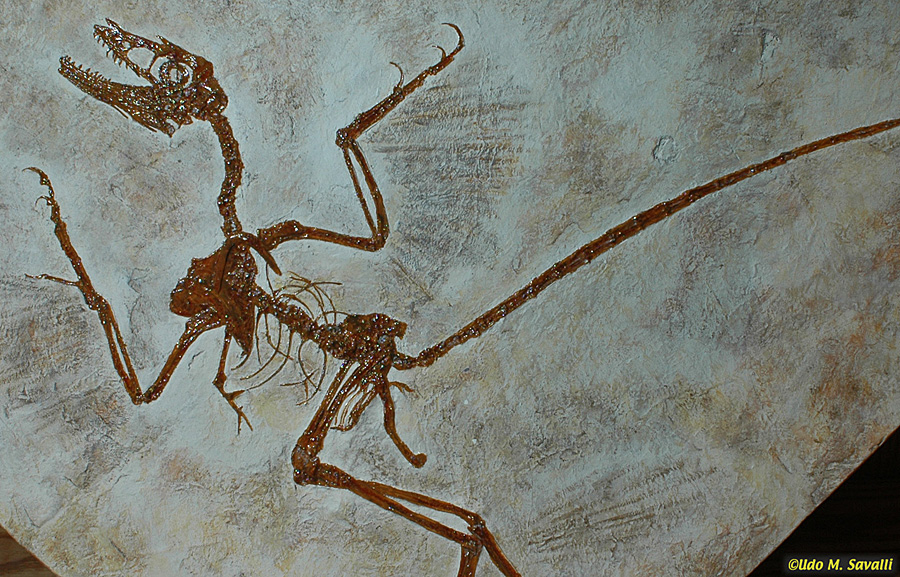
|
|
|
Life model of Microraptor gui, a small dromeosaur with four feathered wings capable of gliding from tree to tree. In life, it was probably an irridescent black color.
Taxonomy: Dinosauria; Theropoda; Maniraptora; Dromaeosauridae
Early Cretaceous Period, 130-125 Ma; China
Fernbank Museum of Natural History, Georgia
|
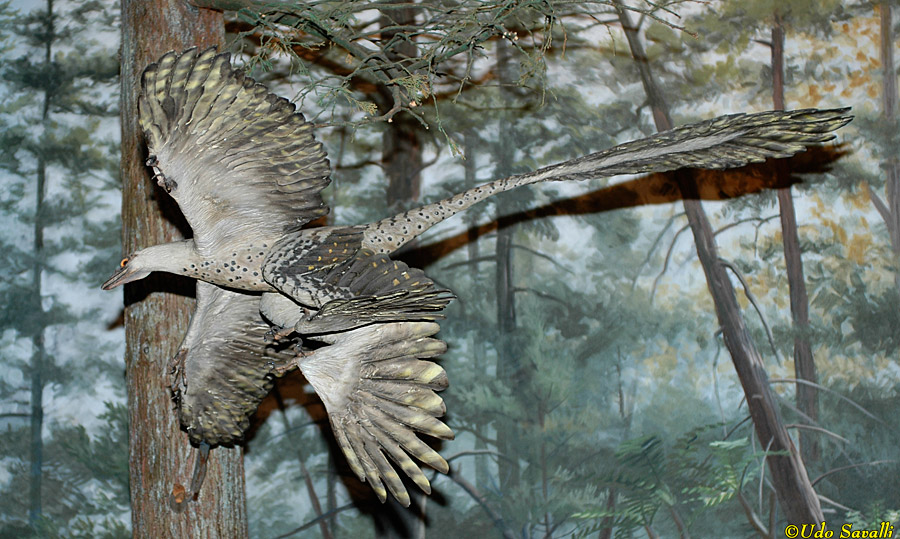
|
|
Troodontidae
|
The family Troodontidae is the sister group to the Dromeosauridae. They differ in tooth characteristics, and in having larger eyes and brains, and smaller slashing claws on their foot.
This egg clutch has been identified as belonging to "Troodon" but that genus is now considered a nomen dubium (dubious name; because it is based on fossil teeth that are not diagnostic), and instead probably belongs to Stenonychosaurus sp.
Taxonomy: Theropoda, Coelurosauria, Paraves, Troodontidae
Teton Co., Montana
Late Cretaceous Period
Museum of the Rockies, Montana
|
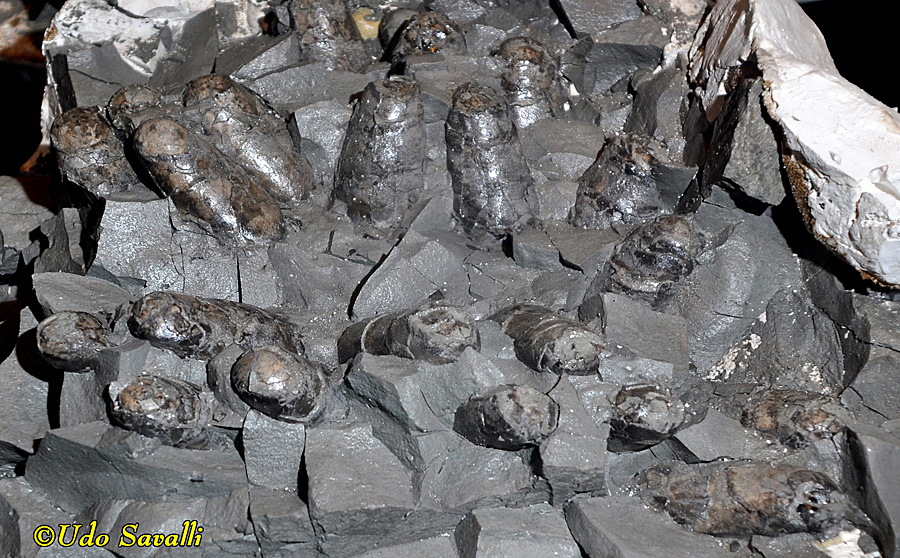
|
|
|
Life models of a pair of Mei long. The fossil of this species was found in a sleeping pose as shown by the individual at left.
Taxonomy: Dinosauria; Theropoda; Maniraptora; Troodontidae
Late Jurassic Period; Colorado
Fernbank Museum of Natural History, Georgia
|
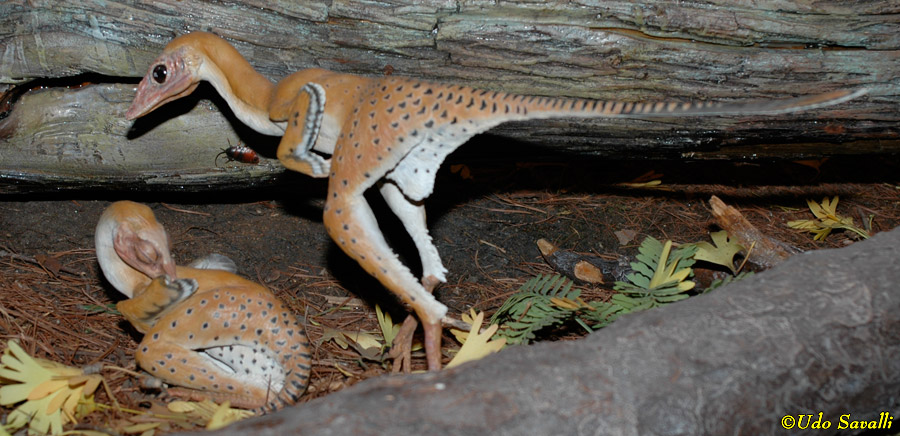
|
|
|






























